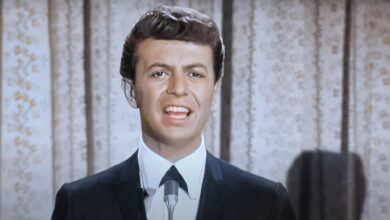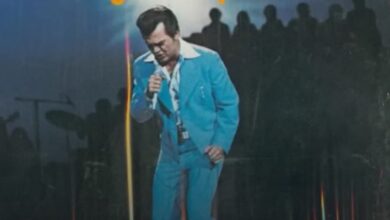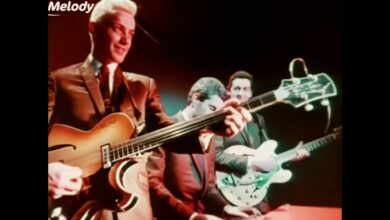Diana Ross’s ‘Ain’t No Mountain High Enough’ Reimagines a Classic, Soaring to the Top in 1970
In 1970, Diana Ross released her solo rendition of Ain’t No Mountain High Enough, a transformative version that not only marked her debut chart-topping single but also showcased her evolution as an artist. This reimagined track soared to the pinnacle of the Billboard Hot 100, solidifying Ross’s successful transition from lead singer of The Supremes to a solo sensation. Unlike the earlier, more upbeat rendition by Marvin Gaye and Tammi Terrell, Ross’s version took a cinematic and gospel-infused approach, redefining the song’s emotional depth.
Born and raised in Detroit, Michigan, Diana Ross first captivated audiences as the lead vocalist of The Supremes, Motown’s premier female group of the 1960s. With hits like Where Did Our Love Go and Stop! In the Name of Love, The Supremes became synonymous with the Motown sound, rivaling even The Beatles in chart success. Ross’s distinctive voice and charismatic presence set her apart, paving the way for a solo career that officially began in 1970 under the careful guidance of Motown founder Berry Gordy.
The song Ain’t No Mountain High Enough was originally penned by the prolific songwriting duo Nickolas Ashford and Valerie Simpson in 1966. Initially intended for Dusty Springfield, the songwriters later brought it to Motown, leading to its first recording by Marvin Gaye and Tammi Terrell in 1967. Their version, with its energetic call-and-response structure, became a defining duet of the era. However, when Ross sought material for her solo debut, Ashford and Simpson saw an opportunity to reimagine the song with an entirely new arrangement, elevating it from a spirited duet to an epic musical statement.
Under the guidance of Ashford and Simpson, Ross’s version underwent a dramatic transformation. Departing from the original’s brisk tempo, this rendition adopted a more cinematic approach, featuring lush orchestration, sweeping strings, and dramatic spoken-word passages delivered by Ross with an almost theatrical gravitas. The Andantes and a choir of background vocalists reinforced the song’s gospel-like intensity, giving it a majestic, sermon-like quality.
Upon its release on July 19, 1970, the single initially faced skepticism from Motown’s Berry Gordy, who was hesitant about its unconventional structure and the absence of a traditional chorus. However, the song quickly gained traction, ascending to number one on both the pop and R&B charts. It remained atop the Billboard Hot 100 for three consecutive weeks and earned Ross a Grammy nomination for Best Female Pop Vocal Performance. The song’s success not only silenced critics but also proved that Ross was capable of captivating audiences outside the context of The Supremes.
This rendition not only showcased Ross’s versatility but also bridged the gap between pop and soul, introducing a broader audience to the emotive power of gospel-infused arrangements. The song’s success underscored the potential of reinterpreting existing material to create something both familiar and refreshingly original. By pushing the boundaries of traditional song structures, it set the stage for other ambitious productions in the 1970s that fused storytelling with grandiose instrumentation.
For Ross, this achievement was pivotal. It affirmed her ability to stand on her own as a solo artist, leading to further successes and solidifying her status as a global music icon. The song’s triumph opened doors to more ambitious projects, including film roles and international tours, further expanding her worldwide appeal. It also proved Motown’s ability to adapt to the evolving music landscape, where songs were becoming more than just radio-friendly hits but full-fledged musical experiences.
The influence of Ross’s version extended beyond her own career. It inspired other artists to explore genre-blending arrangements and demonstrated the commercial viability of orchestral soul productions. The track’s innovative approach has been cited as a precursor to the expansive, dramatic productions that characterized much of 1970s pop and soul music, influencing artists from Barry White to Elton John.
Over the years, Ain’t No Mountain High Enough has been covered by numerous artists, each bringing their unique flair. Notably, in 1981, disco band Inner Life released a dance version that became a club favorite, further cementing the song’s versatility and enduring appeal. The original Marvin Gaye and Tammi Terrell version also continued to enjoy widespread recognition, appearing in films and commercials, but Ross’s interpretation remains the definitive rendition for many listeners.
At the time of the song’s release, Ross was experiencing both professional triumphs and personal challenges. Having recently embarked on her solo journey, she faced immense pressure to prove herself beyond her Supremes legacy. The success of Ain’t No Mountain High Enough not only validated her artistic direction but also marked the beginning of a new era—one in which she would go on to become one of the most celebrated and enduring figures in music history.
In the decades that followed, the song’s legacy endured, frequently appearing on “greatest of all time” lists and remaining a staple of Ross’s live performances. Its message of resilience and unwavering devotion has resonated with generations, making it a timeless anthem of hope and perseverance. Whether through the cinematic grandeur of Ross’s version or the vibrant energy of the original duet, the song has remained a cultural touchstone.
As one of the defining tracks of Ross’s career, Ain’t No Mountain High Enough shaped not only the trajectory of her solo stardom but also the broader landscape of soul and pop music. By embracing bold orchestration, spoken-word storytelling, and a fearless departure from convention, Ross and her collaborators crafted a version that stands as both a reinvention and a masterpiece in its own right. Over 50 years later, its message remains as powerful as ever: no obstacle is too great when passion and determination are at the heart of the journey.



